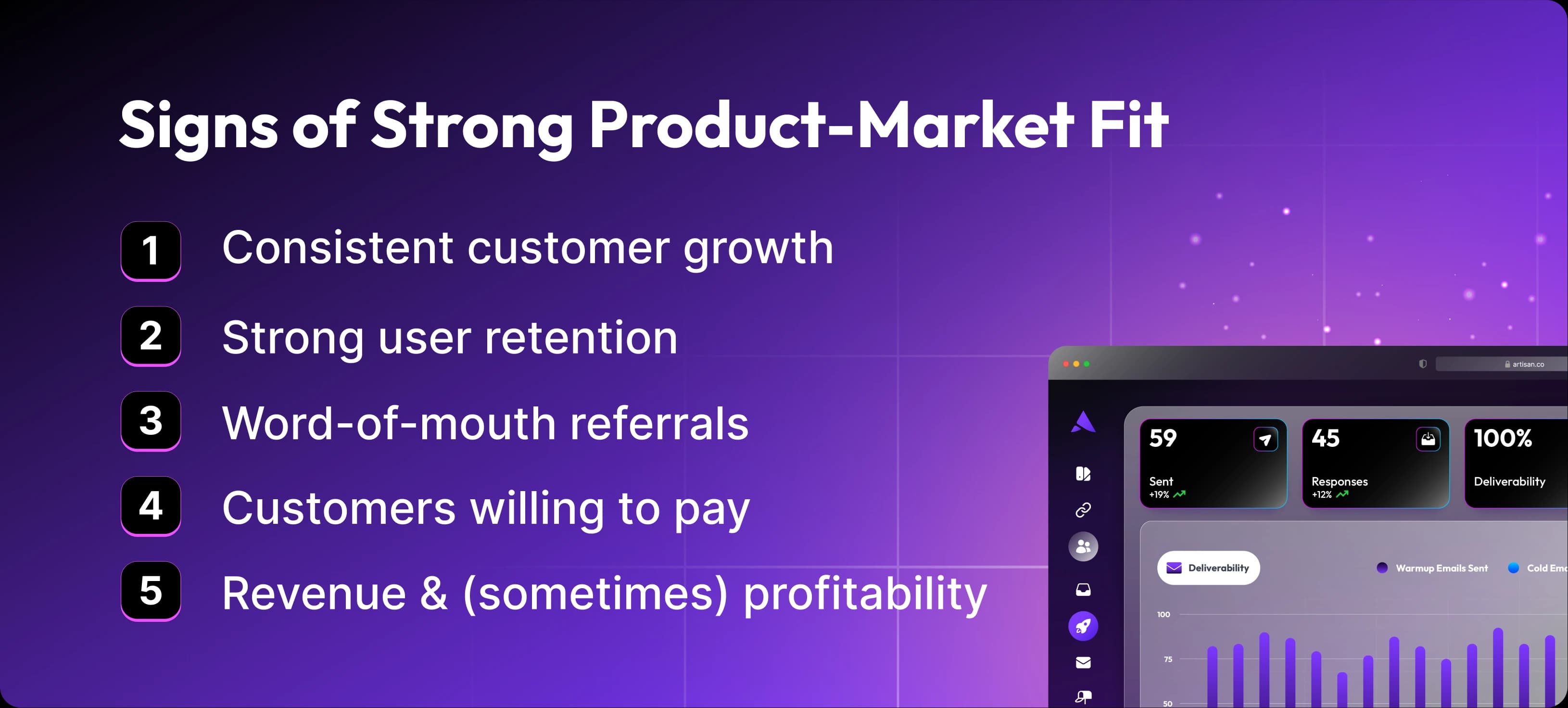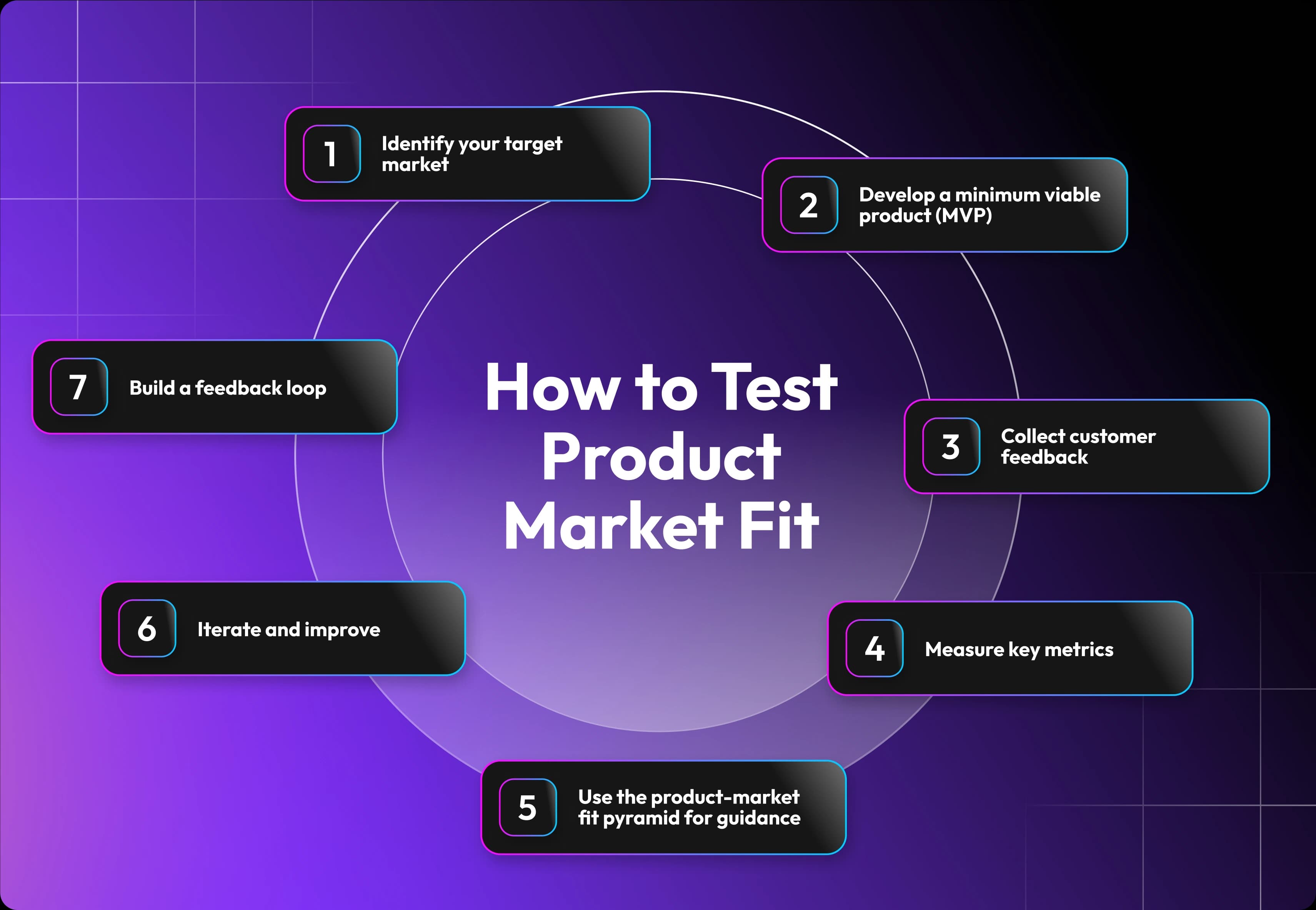Product-market fit sounds straightforward on paper. Make something people want and get it out there. But actually, nailing PMF is like trying to solve a Rubik's Cube in the dark.
You’ve heard the stats. According to the US Bureau of Labor Statistics, nearly half of all businesses fail within five years.
The reason for this huge number? Research shows that product-market fit—or, more precisely, a lack of it—is the leading cause.
So, how can you avoid a similar fate for your business?
It all comes down to thorough testing. You need to test the quality of your product-market fit from the first prototype until well after launch.
Fortunately, that's exactly what you're about to learn. Quick heads up: we'll be using the abbreviation PMF a lot. That's product-market fit, not personal mobile firewall!
Why You Should Test for Product-Market Fit
The concept of product-market fit was popularized by venture capitalist Marc Andreessen, who defined it in the following way: “Product/market fit means being in a good market with a product that can satisfy that market."

Product-market fit is important because it’s a necessary condition for product success. Without it, there’s zero chance you'll be profitable over the long term.
Testing gives you the information you need to determine if you have product-market fit in the early stages of development and lays the foundation for refining and “tightening” it.
Here are some specific reasons why product-market fit is so important:
Validates assumptions. Testing PMF helps you confirm or refute your initial assumptions about your market, customer needs, and product viability.
Minimizes risk and reduces costs. Testing for PMF can identify potential issues early in the product development process.
Enhances customer satisfaction and loyalty. Understanding and aligning with customer needs on an ongoing basis leads to improved satisfaction.
Builds a competitive advantage: Achieving and maintaining PMF can differentiate a business from its competitors.
Keep in mind that you don’t just achieve product-market fit and then forget about it. Yes, it’s especially important during the early stages of a product’s life.
But testing after you’ve successfully brought a product to market will allow you to cement product-market fit in the midst of changing market needs, pain points, macro-trends, and consumer habits.
How to Tell If You Have (or Don’t Have) Product-Market Fit
Testing for product-market fit involves gathering and interpreting data from various sources and sales metrics. This includes both qualitative and quantitative data about your product’s value and the broader business model in which it sits.
Let’s look at the main indicators that show when a company has achieved PMF and when it hasn’t.
Positive Signs of Product-Market Fit
You’ve achieved product-market fit if customer demand is strong and users are actively adopting your product without significant marketing push.
Here are the top indicators of successful PMF:
Consistent customer growth. Your customer base should be growing at a steady rate with a clear marketing and sales ROI.
Strong user retention. If users aren’t dropping off in large amounts, you’re likely solving their problems in a meaningful way. 45
Word-of-mouth referrals. Useful products tend to generate buzz and referrals.
Customers willing to pay. Customers are only willing to pay for products over a sustained period that they’re actively benefiting from.
Revenue and (sometimes) profitability. Profitability—and revenue in the cases of startups that haven’t achieved profitability—is the ultimate barometer of PMF.

You’ll see positive activity in the following KPIs when you have a strong PMF:
Customer growth rate
Churn rate
Net Promoter Score (NPS)
Customer lifetime value (CLV)
Revenue growth
Keep in mind that over-reliance on one metric or PMF indicator can be dangerous. Gathering data from multiple sources reduces the risk of misinterpreting single variables.
For example, you may have strong PMF but see inconsistent customer growth because you haven’t found the right go-to-market strategy. Relying on a product-led rather than a sales-led approach could be one reason for this. Similarly, word-of-mouth referrals or positive public reviews might simply not be common in your industry.
Warning Signs You Haven’t Achieved Product-Market Fit
The flip side of success? Knowing when things aren't working. Here are the red flags that your product-market fit needs work:
Low customer engagement. Product usage is generally the best measure of engagement in the context of PMF.
Lack of enthusiasm. An absence of buzz around your product, especially among early adopters and industry influencers, can be cause for concern.
Frequent feature requests. A large number of feature requests, particularly those related to core functionality, indicates that your product isn’t adequately meeting market needs.
Long sales cycle with low conversions. A long sales cycle with low conversions is usually the result of a product that is failing to sell on its own merits.
Reluctance to pay for subscriptions. Parting with their hard-earned dollars is the surest sign that your potential customers want what you’re offering.

The following “hard” metrics are signs of issues with your PMF:
High churn rate
Low sales conversions
High customer acquisition cost (CAC) compared to industry benchmarks
Negative or neutral feedback
Low revenue growth
As with the positive signs, a full-picture view is imperative. One indicator, while negative, might not indicate problems. On the other hand, two or three present together likely point to issues with your product.
Gathering data about PMF is impossible if you aren’t connecting with your potential customers. Artisan’s AI-powered outreach engine pitches your products or services to thousands of ICP-aligned leads on autopilot. Get in touch to see how it can drive revenue for your business.
Understanding the Product-Market Fit Pyramid
Dan Olsen introduced the product-market pyramid in his book The Lean Product Playbook. It’s since become one of the most widely used models in product development and marketing.
He says, “Whether you work at a startup or a large, established company, we all know that building great products is hard. Most new products fail.”
The product-market pyramid is “an actionable model that defines how to achieve product-market fit.”
It consists of five levels, each of which builds on the preceding one:
Target customer. The initial stage involves defining your target market. Your segment-specific ideal customer profiles (ICPs) should give a clear and detailed overview of your potential customers.
Underserved needs. Here, you identify the unmet needs of your target market. You’re much more likely to achieve strong PMF if nobody is serving the needs of your prospects (or serving them poorly).
Value proposition: Your value proposition is the package of benefits you provide to your target market. It includes, but isn’t limited to, your USPs.
Feature set. Key features deliver your value proposition. Your features are the practical means through which you alleviate the pain points your clients are experiencing.
User experience (UX). It’s vital to ensure that users can easily engage with your product. A clunky, confusing interface can quickly kill a new product. UX should be a priority from the get-go, even at the MVP stage.

When executed in the right way, this model helps you align your value proposition and feature set with real customer needs, a process which is tantamount to finding product-market fit.
The product-market fit model can be understood as an actionable roadmap and as a set of criteria for evaluating your current products.
As an evaluative tool, it can help you hone in on areas you might have overlooked. For example, you may have identified an underserved market and built an excellent feature set, but your user experience could be lackluster and causing customers to drop off.
How to Test Product-Market Fit: A Step-by-Step Guide
Testing your product-market fit has seven stages:
Identify your target market
Develop a minimum viable product (MVP)
Collect customer feedback
Measure key metrics
Use the product-market fit pyramid for guidance
Iterate and improve
Build a feedback loop
Let’s look at each of these in detail.

Step 1: Identify Your Target Market
This step calls for definitions and segments. Lots of them. You can’t achieve product-market fit if you don’t know who your market is.
Here are the four main components of product market research:
Start with the four “graphics.” Demographics, psychographics, firmographics, and technographics. These are a useful basis for defining your target market.
Don’t overcomplicate your ideal customer profile. Ah, the ICP. Your ICP isn’t “VP of sales at a mid-sized tech enterprise with a salary of $200K who enjoys golf and fusion cuisine.” Focus your ICPs on the proven pain points of your market, not arbitrary (and probably incorrect) corporate details and lifestyle descriptions.
Segment, segment, segment. Lumping all of your prospects into one group is a targeting disaster. It will lead to generic marketing and sales campaigns and poor product alignment. Split into segments and prioritize them based on need and ability to buy.
Build your data research tech stack. It’s important to collect both qualitative and quantitative data here. Surveys present opportunities to gather insights about your audience and validate assumptions. Analytics and prospecting tools allow you to dig into hard data.
It’s best to see your ICPs as dynamic documents. Update and refine them as new information becomes available. You can then use your updated ICPs to iterate and test further.
Step 2: Develop a Minimum Viable Product (MVP)
An MVP is a prototype that includes only the features necessary to solve your target audience's primary problems.
It exists for one reason and one reason alone: to validate your idea. It needs to work, but it doesn’t have to be perfect.
Here’s a quick-fire guide to building an MVP:
Define your target market’s central problem and outline essential (and only essential) features.
Put together the technology stack and tools needed for rapid creation and iteration of your MVP.
When building the MVP, focus on core functionality, not perfection.
Integrate a basic user interface (UI). Remember that “basic” doesn’t mean low-quality or unusable.
Test, gather feedback, and iterate quickly based on user insights.
The importance of implementing data collection mechanisms within the MVP can’t be overstated. It wouldn’t be wrong to view your MVP primarily as a tool for generating data.
Whether you opt for limited beta testing or a soft launch, ensure that you have access to usage data and a means of generating qualitative feedback.
Gathering data about PMF is impossible if you aren’t connecting with your potential customers. Artisan’s AI-powered outreach engine pitches your products and services to thousands of ICP-aligned leads on autopilot. Get in touch to see how Artisan can drive revenue for your business.
Step 3: Collect Customer Feedback
Customer feedback is essential, but it’s important not to spread yourself too thin. Often, just two or three solid channels are all that are needed.
Here’s a list of customer feedback methods that may be suitable for you:
One-on-one user interviews
Surveys or questionnaires
Usability testing
Analytics tracking
A/B testing
Heatmaps
Beta testing
Customer support feedback
In-app feedback forms
Social media or community feedback
It’s not uncommon for data gathering to tend towards qualitative methods in the MVP stage, as customer numbers are often limited. When speaking to users, it’s important to ask open-ended questions that prompt detailed feedback regarding preferences and unmet needs.
In addition, feedback collection should be iterative. It’s best practice to foster an ongoing dialogue with users as you develop your MVP. And remember, if you don’t have a large marketing budget, cold outreach using contact details from cold solid database providers can be very useful in the MVP stage.
Step 4: Measure Key Metrics
Key performance indicators (KPIs) should reflect goals at the different stages of your product evolution roadmap. Metrics for an MVP distributed to a 100-person beta testing group will be different to metrics for an established product with a large user base and set pricing model.
Here are the main metrics to consider:
Customer satisfaction
Retention rates
Net Promoter Score (NPS)
Customer acquisition cost (CAC):
User engagement
Daily active users (DAU) or monthly active users (MAU)
Specific feature usage
Win rate (closed-won deals)
Well-chosen analytics tools will track metrics over time and compare results against industry benchmarks. Your “research tech stack” will assist you in this comparison.
It’s also crucial to analyze the reasons behind the numbers, for example by looking at qualitative feedback when satisfaction scores are low. Context is everything, and it’s easy to misinterpret data. When you have a clear understanding of the reasons behind poor performance, you can iterate more effectively.
Step 5: Use the Product-Market Fit Pyramid for Guidance
The product-market fit pyramid is a useful heuristic. If you’re not seeing the results you want, it’s likely because you haven’t adequately built one or more of the pillars elaborated in the model.
If you can tie feedback and metrics to specific parts of the model, you’re much more likely to identify an accurate and useful context. This will enable you to make informed changes and move forward more effectively.
For example, if user engagement is low but your sales win rate is high, it may be due to a subpar user interface. Alternatively, if your conversion rate is solid but your churn rate is high, this may speak to a misunderstanding of your target customers or an incomplete feature set.
Step 6: Iterate and Improve With an Agile Approach
Achieving a strong PMF is, in large part, about knowing how to iterate. Agility is a much overused buzzword, but it’s highly relevant when it comes to tailoring your product to the needs of your market.
An agile approach will allow you to respond quickly to data, prioritize the most important changes, and drive effective ongoing optimizations.
Generally speaking, an agile, iterative framework will have the following components:
User feedback loops
Usability testing
Data-driven feature prioritization
Rapid prototyping
A/B and multivariate testing
Fast product releases
Ongoing user interviews
Keep in mind that your user base is the ultimate barometer when it comes to iteration. Changes will be reflected in key user metrics like engagement, feedback, referrals, and hard revenue.
Step 7: Build Feedback Loops
The final piece of the puzzle is gathering high-quality feedback quickly and consistently.
Here are several communication channels that will allow you to gather immediate (or near-immediate) feedback:
Social media
Newsletters
Surveys and satisfaction polling
Forums
Dedicated focus groups
Internal teams that interact with customers such as sales enablement teams are often overlooked as sources of data.
It’s also vital to stay informed about market activity and competitor offerings, adjusting your strategy as necessary. Your user base is primary, but it’s important not to ignore larger industry macro trends.
Wrapping Up Your Product-Market Fit Journey: What’s Next?
Achieving product-market fit is ultimately about iterative testing and high-quality feedback loops.
You can have the best theory in the world—and the product-market fit pyramid is an excellent conceptual basis. But there is only one way to truly know whether you’ve achieved a strong PMF: by taking your offering to the market.
And that’s when the real data-gathering and analysis begins.
It’s equally important to remember that PMF testing isn’t just for the launch period. Products that are successful over the long term adapt to evolving customer needs.
When you put the concept of PMF at the center of your business model, you future-proof yourself against the inevitable ups and downs of the market.
Found Product-Market Fit? Let Artisan Connect You With Ready-to-Buy Prospects
Artisan is a next-gen outbound sales platform that connects you with your ideal prospects. It uses the very latest AI technology to automate substantial parts of the sales process.
At the core of Artisan’s AI platform is Ava, a virtual sales development representative (SDR). She has access to a database of over 300 million leads and can run full outbound campaigns on autopilot.
Access to a high-quality pool of leads is essential to measure product-market fit at all stages of a company’s growth. Whether you're validating an early-stage MVP or testing new features in a product with a large user base, cold outreach is one of the fastest, most cost-effective ways of reaching potential customers.
Artisan can automate and streamline all of the following tasks:
Prospecting from an up-to-date pool of over 300 million B2B leads
ICP and market segmentation optimization
Highly targeted personalization based on a unique “waterfall”
Email address warm-up and email deliverability optimization
A/B and multivariate testing of cold email content
Social media outreach on autopilot
Integration with your CRM, ERP, accounting software, etc.
Ready to find your perfect customers? Book a demo to see how Artisan can connect you with prospects who actually need what you're selling.

